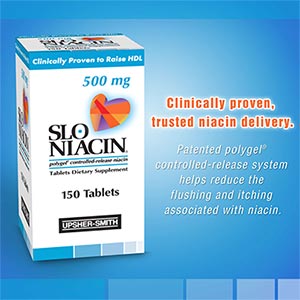Niacin best for raising good cholesterol


(Picture from Costco.com.)
Try a timed-release niacin, and be skeptical if your doctor gives the sales pitch for Zetia or Vytorin.
The authority for this is a study dubbed ARBITER-6, which was stopped suddenly this summer, with the study's authors insisting safety had nothing to do with it.
It was a question of efficacy.
The results, described in the New England Journal of Medicine, make clear that niacin does better at the main job, keeping arteries open.
"The use of extended-release niacin causes a significant regression of carotid intima–media thickness when combined with a statin and that niacin is superior to ezetimibe."
Ezetimibe is the generic name for the active ingredient in Zetia, while Vytorin combines the same drug with a generic statin, simvastatin.
This does not mean ezetimibe is worthless. It works. It just doesn't work as well as niacin.
This has important implications for anyone who, like me, has a family history of hypertension and high cholesterol. But if you want to save some serious money, look further.
The ARBITER-6 study compared ezetimibe with Niaspan, a drug form of timed-release niacin. But you can get similar dosages, for a lot less, with a supplement containing the same stuff. I use something called Slo-Niacin.
On most insurance plans you'll pay $10/month for a generic statin and $30/month for Niaspan, or $30 for Zetia, "saving" $10 by using Vytorin (which contains the statin).
But Costco offers 150 Slo-Niacins for about $10, so even if you double your dosage to 1 gram (as many doctors recommend, taking one in the morning and one at night to prevent flushing), that's $14/month for simvastatin and niacin, or $30/month for Vytorin.
Last time I got checked out, my combination of simvastatin and 1 gram of SloNiacin per day was working like a champ. Total cholesterol under 150 and a ratio of bad to good that had my doctor putting exclamation marks on my chart.
The paragraphs above, combined with the results of ARBITER-6, represent the heart of comparative effectiveness, and the way we old-timers can interpret those results to stay healthy for less.
As health IT begins collecting hundreds of millions of health records over the next several years studies like this will become easier to do, and they will be more accurate, given the larger number of records being studied.
But this is bad news for drug-makers. You not only have to prove safety, not only prove that your drug does what it claims, not only prove you're better than a placebo, but you now have to prove you're better than alternatives before you're going to get the big money.
Bad for drug companies, good for patients. That's what comparative effectiveness studies are all about.